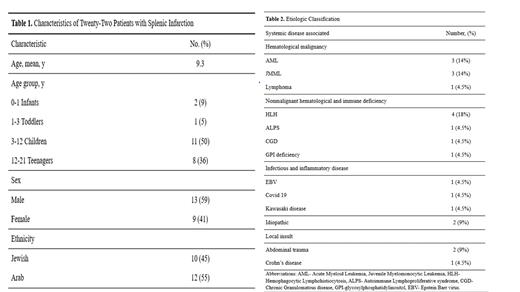Introduction: Data regarding splenic infarction (SI) in the pediatric age group are limited and mostly confined to case reports. Studies in the adult population suggest that cardiogenic emboli and atrial fibrillation are the predominant etiologies among the elderly. The aim of the current study was to explore the risk factors, management, and recurrence rates of SI among children diagnosed with SI in a tertiary center.
Methods: We queried the radiology database at Sheba Medical Center from November 2013 through June 2023 for children (age ≤ 21 years) diagnosed with splenic infarction, using search terms “splenic” or “spleen” and “infarct” or “infarction.” We reviewed the electronic medical records corresponding to each case and entered clinical and laboratory data at presentation, as well as data regarding therapeutic management and outcomes.
Results: Twenty-two children with SI were identified. The demographic and clinical data of these patients are presented in Table 1. The cohort comprised 14 males (64%) and 8 females (36%), with a median age of 7.9 years (interquartile range [IQR]: 3.9-14.5 years) at the time of SI diagnosis. The median follow-up period was 5 months (IQR: 2-32 months). The majority of patients (73%) had pre-existing medical conditions, mostly malignant and non-malignant hematological diseases, as shown in Table 2. Splenomegaly was prevalent, with 72% of patients having a spleen size larger than the suggested upper value for their age.
Reasons for performing imaging were diverse and included the evaluation of splenomegaly (9/22 subjects), assessment due to fever (4/22 subjects), and traumatic abdominal injury (2/22 subjects). In 7/22 subjects, imaging was performed due to abdominal pain, mostly in the left upper quadrant.
Following the diagnosis of SI, further evaluation of patients varied. Echocardiograms were performed in 86% of the children, with 14 out of 19 patients having normal results. Mild pericardial or pleural effusions were noted in 3 patients, reduced ejection fraction in 1 patient, and 1 patient with Kawasaki disease had multiple giant aneurysms. Thrombophilia workup was conducted in 13 out of 22 patients, with three of them showing clinical findings, including 2 patients with heterozygous Factor V Leiden and one patient with reduced protein S levels.
Regarding treatment and outcomes, only 4 out of 22 patients received antithrombotic medications. All four were initially treated with anticoagulation, two of whom later transitioned to aspirin. Two patients in the cohort experienced recurrent SI, one of whom received antithrombotic therapy. None of the patients experienced thrombotic complications other than SI. 36% of children and infants died during the follow-up (median from SI to death - 3 months, IQR: 0.5-5 months). In all cases, mortality was related to infectious complications or progression of hematological disease. There were no fatalities due to thrombotic or bleeding complications.
Discussion: Our study suggests that hematological disease and associated splenomegaly are the most common risk factors associated with pediatric SI. Only a minority of patients in our cohort received antithrombotic treatment. This finding is in striking contrast to publications regarding the management of adults with SI, where almost all patients were given anticoagulant treatment. This disparity in management most probably stems from the different etiology of SI between adults and children. While thromboembolism due to atrial fibrillation or atherosclerotic disease is common among adults, these conditions are extremely rare in the pediatric population and were not observed in any of the children in this study. The majority of cases in our cohort were associated with splenomegaly, suggestive of auto infarction due to a rapid increase in spleen size. Caution is advised in applying anticoagulation in this setting as it may be associated with intra-abdominal bleeding. In this respect, it is reassuring that none of the patients experienced other thrombotic complications.
Disclosures
Levy-Mendelovich:Roch LTD: Honoraria; Novo nordisk: Honoraria, Research Funding; Pfizer: Honoraria, Research Funding. Cohen:Roch LTD: Honoraria. Kenet:Roch LTD: Honoraria; pfizer, Anlyam, BPL, Bayer, Okpo, Pfizer, Shire , Roche: Honoraria, Research Funding. Barg:pfizer: Honoraria; Roch LTD: Honoraria, Research Funding.


This feature is available to Subscribers Only
Sign In or Create an Account Close Modal